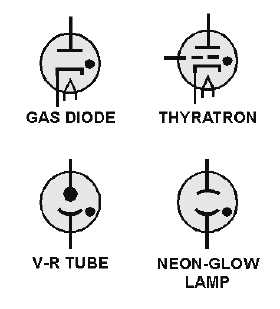2-16
Figure 2-15.—Schematic diagram of gas-filled tubes.
Before leaving this section, you should be aware of one precaution associated with mercury-vapor
tubes. The mercury vapor is not placed in the tube as a vapor; instead a small amount of liquid mercury is
placed in the tube before it is sealed. When the liquid mercury comes in contact with the hot filament, the
mercury vaporizes.
To ensure that the mercury has vaporized sufficiently, the filament voltage must be applied to
mercury-vapor tubes for at least 30 seconds before the plate voltage is applied. If vaporization is
incomplete, only partial ionization is possible. Under these conditions, the application of plate voltage
results in a relatively high voltage drop across the tube (remember E = I × R), and the positive ions
present are accelerated to a high velocity in the direction of the cathode. As the ions strike the cathode,
they tear away particles of the emitting surface, usually causing permanent damage to the cathode and the
tube. When the mercury is completely vaporized, the action of the gas is such that the voltage drop across
the tube can never rise above the ionization potential (about 15 volts). At this low potential, positive-ion
bombardment of the cathode does not result in damage to the emitting surface.
Generally, when gas-filled tubes are in the state of ionization, they are illuminated internally by a
soft, blue glow. This glow is brightest in the space between the electrodes and of lesser intensity
throughout the remainder of the tube envelope. This glow is normal and must not be confused with the
glow present in high-vacuum tubes when gases are present. A high-vacuum tube with a bluish glow is
gassy and should be replaced. The ionization of these gases will distort the output of the tube and may
cause the tube to operate with much higher plate current than it can carry safely.
COLD-CATHODE TUBES
The cold-cathode, gas-filled tube differs from the other types of gas-filled tubes in that it lacks
filaments. Thus, its name "COLD-CATHODE TUBE." In the tubes covered in this text thus far,
thermionic emission was used to send electrons from the cathode to the plate. This conduction of
electrons can be caused in another manner. If the potential between the plate and the cathode is raised to
the point where tube resistance is overcome, current will flow from the cathode whether it is heated or



